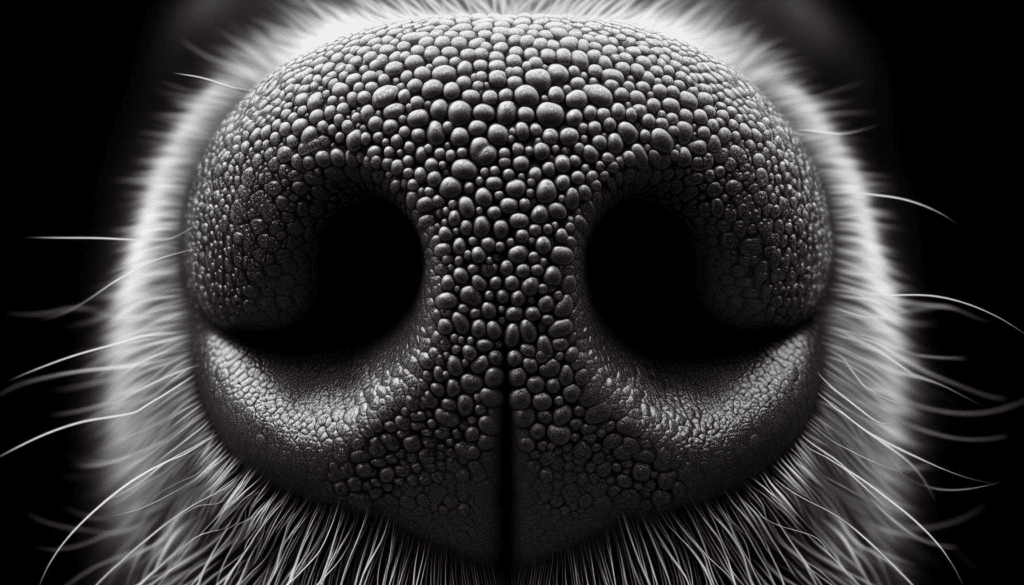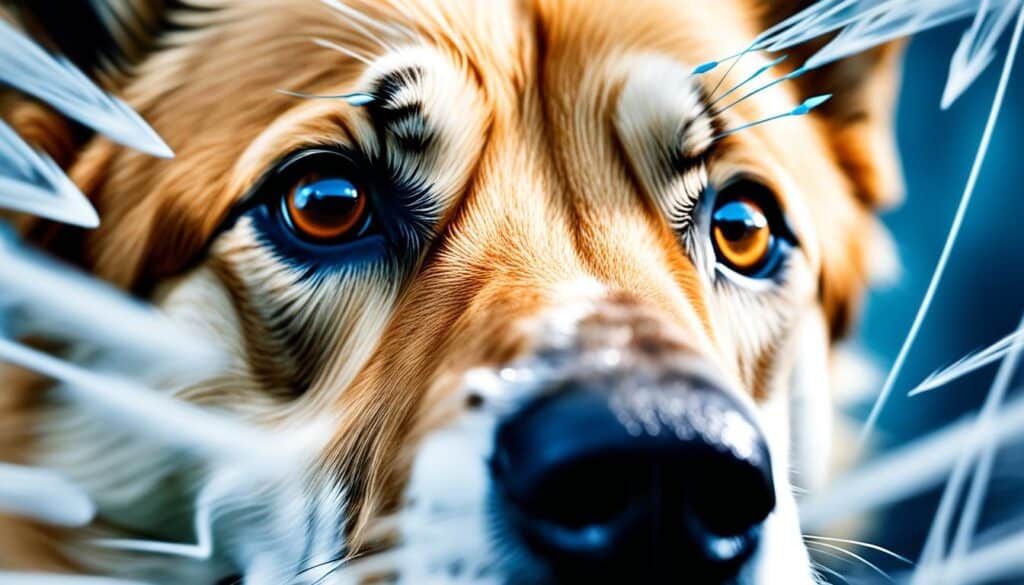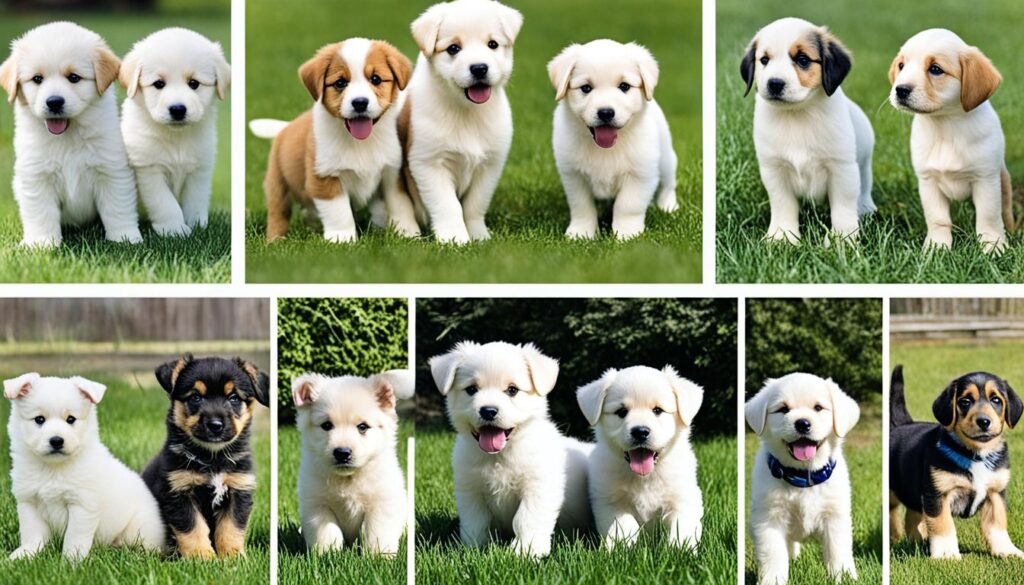Welcome to the fantastic world of canine olfaction. Here, dogs have a sense of smell better than ours. They can find hidden objects and track scents over long distances. This sense of smell is critical for dogs to understand their world.
Dogs have a nose that is specially built for smelling. They have many scent receptors in their noses. This lets them smell a wide range of odors. Besides their noses, dogs also have special odor receptors in their nasal cavities. This helps them process scent information very accurately.
So, how do dogs apply their sense of smell in real life? They can find specific smells in a complex mix, follow scents over long distances, and even smell sickness in people. The way dogs smell is fantastic. We’ve used this knowledge in different ways, like search and rescue missions and detecting illnesses.

Key Takeaways:
- Canine olfaction is a remarkable sense that surpasses human capabilities.
- Dogs have specialized anatomy and olfactory receptors that enable their sense of smell.
- Dogs use their sense of smell for various practical real life situations, such as search and rescue missions.
- The science behind canine olfaction reveals fascinating insights into their behavior and abilities.
- Understanding and appreciating dogs’ sense of smell strengthens the bond between humans and dogs.
The Fundamentals of Canine Sense of Smell
Dogs see the world primarily through their noses. Smelling is very important for them. Their sense of smell is much better than ours. It lets them do many things.
Understanding How Dogs Use Their Sense of Smell
Dogs use smell to learn about the world. This skill helps them find food and stay safe. Since their nose is so powerful, they can tell many smells apart.
Components of the Canine Olfactory System
Their smelling ability comes from several parts working together:
- Nostrils: Dogs have moist and highly sensitive nostrils that capture scent molecules.
- Olfactory Epithelium: Located inside the nasal cavity, the olfactory epithelium contains millions of olfactory receptor cells that detect different odors.
- Olfactory Bulb: The olfactory bulb processes the signals from the olfactory receptors and sends them to the brain for interpretation.

The Role of Olfactory Receptors in Dogs’ Scent Detection
Special receptors help dogs smell. These are proteins on cells in their noses. When they smell something, these proteins send a message to the brain. This is how dogs know what they are smelling.
How Do Dogs Use Their Nose to Detect Scent?
Dogs have a fantastic way of detecting scents. This process includes several steps. It starts with a smell entering their nose and finishes in their brain.
Examining the Process of Scent Detection by Dogs
First, a dog catches a scent with its nose. They breathe in, letting air with scent molecules inside. Their nostrils and the inside of their nose help to process these scents.
In the nose, there’s a special tissue called olfactory epithelium. It has many olfactory receptors. These receptors catch the scent molecules.
After catching the scent, chemicals are released. They send signals to the dog’s brain. The brain then starts to understand what the smell means.
The Importance of the Olfactory Epithelium in Odor Detection
The olfactory epithelium is critical for dogs to smell well. It has many olfactory receptors. These receptors are susceptible.
This part of the nose also has cells that help the receptors work. They keep the receptors healthy.
Differentiating Odors: How Dogs Can Smell So Well
Dogs are great at telling different smells apart. They have a lot of olfactory receptors. This helps them smell things.
They have much more olfactory receptors than humans. This is why they can smell so much better than we can.
And their brain parts for smelling are well-developed. This helps them know exactly what a smell is.
In conclusion, dogs have a unique ability to detect scents. Every part helps them smell the world from their nose to their receptors.
Canine Olfaction vs. Human Sense of Smell
Dogs have a fantastic sense of smell that far outclasses humans. This difference in smell detection comes from dogs having more smell receptors and a more significant part of the brain dedicated to smelling. This makes their smell much sharper than ours.
Dogs boast about 300 million smell receptors. Compare this to a human’s 6 million. These receptors are tiny, sensitive cells that catch smells in the air. With so many, dogs can notice and identify scents better than we can.
Besides owning more smell receptors, dogs enjoy a more significant smell-processing part in their brains. This part, known as the olfactory bulb, helps them deal with smell information better. More efficient smell processing means a dog’s sense of smell is even more finely tuned.
Dog noses are also crafted to smell in a big way. They feature a thin tissue in their nose, where those millions of smell receptors sit. For dogs, this tissue is not only more extensive but also more intricate. It gives them plenty of space for smell molecules to latch onto.
| Feature | Dogs | Humans |
| Number of Olfactory Receptors | Approximately 300 million | Approximately 6 million |
| Size of Olfactory Bulb | Larger | Smaller |
| Size of Olfactory Epithelium | Larger and more complex | Smaller and less complex |
In simple terms, dogs are way better at smelling than us. Due to many receptors, a big brain part, and specialized nose tissue, their impressive smell system gives them a clear edge. We should marvel at how dogs experience the world through their fabulous nose.
Applications of the Canine Nose: From Detection Dogs to Pet Companions
Dogs have a fantastic sense of smell that’s very useful in many areas. They help in security, search work, and medical and disaster missions. As pet companions, they rely on smell to understand their world. This shows how essential and versatile their sense of smell is.
The Role of Sniffer Dogs in Security and Search Operations
Sniffer dogs are essential in security and search tasks. They can find things like drugs, explosives, and human remains with great accuracy. Their nose saves lives by ensuring safety and security through their detection skills.
How Trained Dogs Contribute to Medical and Disaster Relief Efforts
Trained dogs also help in health and emergency missions. They can sniff out illnesses like diabetes and some cancers. In disasters, they find people under the rubble. This quickens the emergency response.
Understanding How Domestic Dogs Use Scent in Everyday Life
Pet dogs use their strong sense of smell in their daily routines. They find their way back, recognize smells and objects, and feel their human emotions. Their smell is vital in their communication and experiences with the world.
Enhancing the Olfactory Abilities of Man’s Best Friend
Dogs have a fantastic sense of smell. We can make it even better through special training. This training helps them use their smell better, making them good at finding certain scents.
Training Techniques for Scent Detection Dogs
Training dogs to find smells uses a step-by-step method. First, they sniff different smells to learn them. Then, they learn to connect the smells to actions. They get treats and praise when they get it right. This method teaches them to find smells well.
There are different ways to train dogs to find smells. Some ways involve just letting them smell things. Other ways teach them actions based on what they see. And they might get rewards or corrections to learn better.
The Impact of Diet and Health on Canine Olfactory Function
A dog’s diet is also vital for their smelling sense. A healthy diet helps their smell stay strong. Foods with antioxidants and omega-3 are suitable for this. They boost how well dogs can smell.
Sometimes, health problems can stop a dog from smelling right. Checking at the vet regularly is essential. It helps catch and treat problems early. This keeps a dog smelling at its best.
Good training and diet can make a dog’s smelling skills top-notch. They become great at finding scents. This is very helpful in jobs like searching for and rescuing sick people.
Insight into How Dogs Interpret the World Through Scent
The scent is vital for dogs to perceive the world. They use smells to chat with other dogs, sense how humans feel, and get what’s happening around them. The link between smell and canine ways is essential. It helps us see how dogs move around their space and connect with other animals and people. Dogs also use sight and smell together. They do this to understand their area better.
Exploring the Relationship Between Scent and Canine Behavior
Dogs’ lives heavily depend on their sense of smell. It helps them learn and move through their world. With smell, they talk to other dogs. They share who they are, their feelings, and even health clues. Scent marking shows up when dogs tag objects or spots. They do that to claim territory, set limits, or speak with other dog pals. Learning about scent can teach us a lot about dogs’ friendships and ways of talking.
How Dogs Use Both Sight and Smell to Assess Their Surroundings
Dogs check out their world in unique ways. They use both smell and sight. Their smell is super strong, picking up on even the faintest odors. But they also look around to see what’s there visually. By using both, dogs understand their surroundings fully. They spot dangers or interesting spots and make choices relying on both senses.
| Assessment | Senses Involved |
| Identifying Familiar Objects | Scent, Sight |
| Detecting Potential Danger | Scent, Sight |
| Evaluating Other Animals | Scent, Sight |
| Navigating Social Interactions | Scent, Sight |
Scent and sight together let dogs gather so much about their surroundings. This helps them make smart choices and engage with their space and others in ways that mean something.
Conclusion
Dogs have a fantastic sense of smell better than humans. Their noses are designed for perfect sniffing, letting them tell different scents apart. Knowing how dogs smell helps us train them better and understand their actions.
The connection between us and dogs grows when we know about their smell. With their powerful nose, dogs see the world unlike we do. Smelling helps them in daily life and helps them understand their surroundings.
Dogs with a sharp smell help in many ways, from keeping us safe to healthy. Sniffer dogs protect our neighborhoods. Others help find people when they’re lost or smell diseases. At home, pet dogs use smell to remember places and people.

